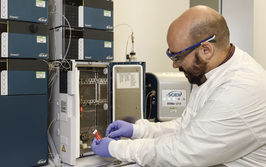Characterization of biopharmaceutical stability with Differential Scanning Calorimetry

contributed by Malvern Panalytical |
Introduction
The stability of a biopharmaceutical protein is critical to the success or failure of the development of a viable drug. Protein stability is important for production, manufacturing, formulation, long term storage, delivery to patient, and efficacy. Highly stable proteins will likely have fewer issues during the manufacturing process, are more cost-effective to produce, and are more likely to remain functional during formulation and storage without chemical alteration or aggregation. In the 'Quality by Design' (QbD) approach for biopharmaceutical development, stability characterization is part of the assessment of the 'developability' and 'drugability' of any candidate molecule, as well as during process development and manufacturing. Stability data is also incorporated in higher order structure (HOS) characterization and “fingerprinting” used for manufacturing support, biopharmaceutical comparability and biosimilarity assessment. In addition, protein HOS characterization is becoming 'expected' in regulatory submissions for new biopharmaceutical drugs and biosimilars.
Due to the complex nature of proteins, biophysical tools are important for the complete characterization of a biopharmaceutical product. There are several biophysical tools used to assess protein stability, including (but not limited to) circular dichroism (CD), dynamic and static light scattering (DLS and SLS), size-exclusion chromatography–multi-angle light scattering (SEC-MALS), Fourier transform infrared spectroscopy (FTIR), analytical ultrafiltration (AUC), size exclusion chromatography (SEC), differential scanning fluorescence (DSF), intrinsic fluorescence (IF) and differential scanning calorimetry (DSC).
Log in or register to read this article in full and gain access to The Medicine Maker’s entire content archive. It’s FREE!



















